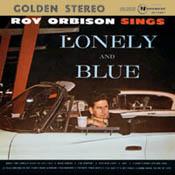Roy Resurrected
Lonely and Blue, the rarest and most valuable of Roy Orbison's Monument LPs--his first for the label--has been given splendid sonic and packaging care by Classic Records, in both monophonic and stereo editions. According to Classic's Mike Hobson, this is the first time the original master tapes have been used since the original pressings were issued in 1961. At a January 2003 Consumer Electronics Show press conference, Hobson told how the masters were discovered in Nashville and gave every indication of having not been "cracked" since they were used to generate the original LP. What Mobile Fidelity used for its gold CD, or Sony for its gold CD, remains a mystery, then, but when you hear this issue, you'll have no doubt the original tapes were used--especially if you've become accustomed to those CDs.
I once attended a record auction at the Doyle Gallery in midtown Manhattan, where I bid on and won a box of LPs in the "O" category. It included many mint original Monument mono and stereo Orbison albums, but not Lonely and Blue, which had been pulled and auctioned separately. It was a mono Lonely and Blue, but it went for a few hundred dollars. Had it been an even scarcer stereo edition, it probably would have fetched $1,000 or more.
When you hear this chestnut you may wonder what the fuss is about musically, but sonically you'll recognize a great Bill Porter recording, whether you choose the mono or the stereo edition. Porter, who recorded Orbison, Elvis, and many other artists for Monument and later RCA, told in a late-'80s interview for The Absolute Sound that he liked to record everything "from D.C. to light." The veteran engineer is still active as a recording engineering teacher.
Porter also told me about how he contributed to the unique Orbison sound, which featured back-up singers adding the "dum dum dum dumby doo wah"s in a closely miked bare whisper. With its title and songs of loneliness and heartbreak, this album sets the formula for Roy's '60s career, which influenced Lennon and McCartney among other luminaries of the decade. (In fact, Orbison toured with The Beatles, who were big fans.)
Backed by Bob Moore and his orchestra and chorus, Roy opens with his classic "Only the Lonely (Know The Way I Feel)," and keeps the heartache coming with Boudleaux Bryant's "Bye Bye Love," which of course was a big hit for The Everly Brothers. Bryant supplies the set's liner notes, as well. Roy ably covers "Cry" (with which Johnny Ray scored big a few years earlier), a pair of Don Gibson classics ("I Can't Stop Loving You" and "(I'd Be) A legend In My Time"), and Gene Pitney's "Twenty-Two Days"--but the highlights are the Orbison-Joe Melson originals, including "Only the Lonely," "Blue Avenue," "Come Back To Me (My Love)," and "Blue Angel"--the last of which, as songwriter Bryant notes in his laudatory liner notes, features background vocals bordering on parody.
Orbison croons in his enormous, dramatic, operatic voice over the string-driven orchestra and whispering background singers, and the combination is both ornate and campy. If you're familiar with The Everly Brothers' lean, driving, teenage take on "Bye-Bye Love," Orbison's string-drenched take will sound positively baroque. Most of these tracks would have sounded over-the-top in 1960. Today they sound almost Liberace-like, though enjoyable nonetheless.
The string-saturated 1960s Nashville sound was called "countrypolitan," but these tunes are heavier on the "politan" than they are on the "country." The arrangements may be campy and perhaps too much for contemporary sensibilities, but the magic in Orbison's voice transcends time. And between Porter's recording and Bernie Grundman's mastering, you'll never feel closer to hearing Roy live as you will here. Back in the mid-1980s, before his career was resurrected by Jeff Lynne, Tom Petty, and The Traveling Wilburys, Roy played a Playboy party at The Drake Hotel in Chicago during a summer CES Show. I was lucky enough to stand in front of the stage behind the P.A. system, so I could hear Roy's still-incredible unamplified voice. These editions come as close to hearing Roy live as you're going to get.
As between the stereo and mono editions, both have their strong suits and enthusiastic supporters. Even if you're a stereo fanatic, though, please consider the mono edition. It has a coherence and consistency the stereo edition can't match--good as it is. If you're unfamiliar with Orbison and/or Bill Porter, pick one of these up and you'll hear why so many of us oldsters think the art of recording has slipped badly over the past few decades. One of Classic's better-sounding reissues--mono or stereo--and highly recommended.



